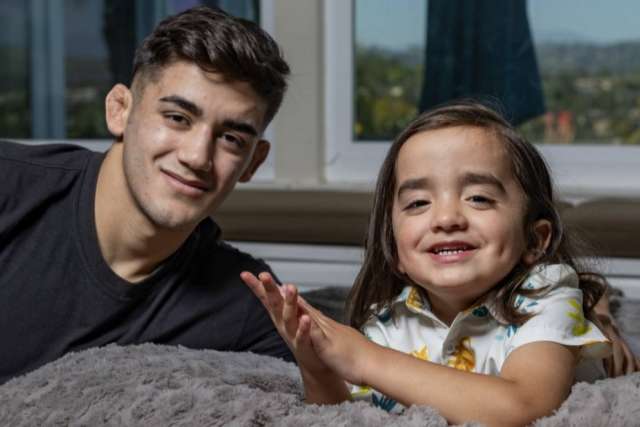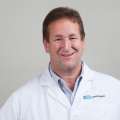Photo: Aaron Nagao, left, and brother, Joziah, both were born with X-linked lymphoproliferative disease. (Photo by Joshua Sudock, UCLA Health)
It might seem nothing could be more traumatic for a new parent than to find out their baby has been born with a deadly immune system disorder that can only be cured after a worldwide hunt for a bone marrow match.
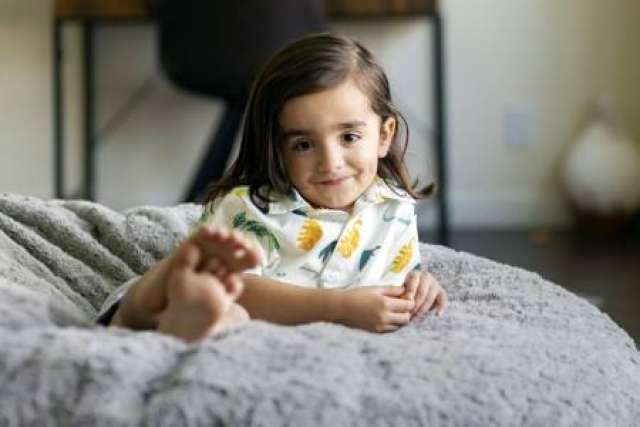
But when Eric and Desiree Nagao learned two years ago that their baby boy, Joziah, was diagnosed with X-linked lymphoproliferative disease, they were calm and confident that everything would be all right.
That’s because right in front of them was his big brother, Aaron, who was born with the same disease in 2003. Aaron received a successful bone marrow transplant at UCLA, grew up to become a state champion wrestler at Esperanza High School in Anaheim and now is on a full athletic scholarship to the University of Minnesota.
The family credits Theodore B. Moore, MD, division chief and program director of the Pediatric Blood & Marrow Transplant Program at UCLA, along with his colleagues, for saving the lives of both of their sons.
“Dr. Moore was amazing in how he gave us the assurance that everything would be OK, with both of our boys, and then he made that happen,” said Eric Nagao, the boys’ father.
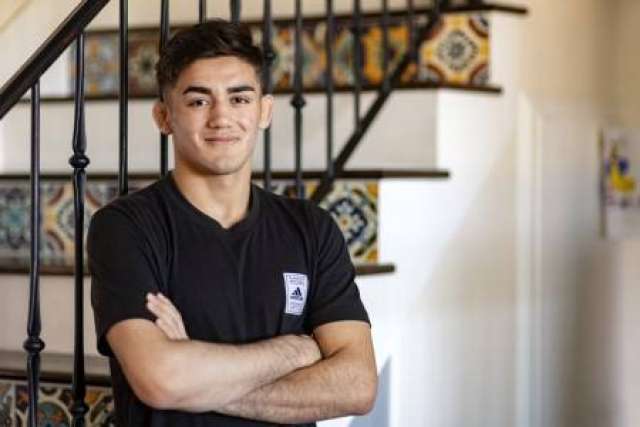
“It’s a remarkable gift that he has for what he does, to bring utter calmness to us in our absolute time of need,” said Nagao, a captain and paramedic with the Santa Monica Fire Department. “It is a special gift that not everyone possesses. When we could have felt complete despair, he made us feel like, hey, he’s got this handled. He has seen it before, and he knows exactly what to do to help our boy get through this.”
Potentially deadly disease
Treatment for XLP, a hereditary immune system disorder that predominantly affects males, requires transplanting healthy blood stem cells from a donor who is compatible with the patient. It can be difficult to find a compatible donor, but an international database saved the Nagao boys both times, with donor cells coming from Sweden and the United Kingdom, respectively.
The transplant is essential, because without it, 50% of people with XLP are likely to die from their own immune system’s exaggerated response to the Epstein-Barr virus (EBV). The condition typically causes the patient’s immune system to attack internal organs and the blood-producing cells in the bone marrow.
Most humans at some point will contract EBV, which can cause the mild condition of infectious mononucleosis, commonly called mono, for those with healthy immune systems.
Evolving science
When Aaron Nagao was treated in 2003, no family members were a compatible match for donation. But Dr. Moore found a match from a stored umbilical cord in Sweden and performed the successful transplant.
Dr. Moore began doing these procedures in the 1990s and said he is pleased that he and his colleagues have been able to consistently advance the treatment.
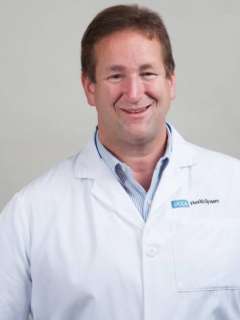
“It is very satisfying to be able to help these families, when there simply is no other cure for the disease other than a bone marrow transplant to save their baby’s life,” Dr. Moore said. “The pleasure was mine to be able to help with this, for such a phenomenal family like the Nagaos.”
Aaron had a tough time for a couple of years, with frequent emergency department visits, said his mother, Desiree Nagao. As a young boy he had many bouts with infections and fluctuating weight from taking medication such as prednisone. But his parents trusted Dr. Moore and the other UCLA physicians involved.
“They took really good care of him at UCLA, and made us feel very comfortable throughout the process,” she said. “By the time he was in kindergarten he was good to go, with no health problems.”
The family knew their second son, Joziah, had a 50% chance of inheriting the disease when he was born in 2018. When doctors confirmed it, they were concerned but confident that UCLA could provide a cure.
Eric Nagao said the most stress he and his wife felt during Joziah’s treatment came in securing the donor cells. Ultimately, the cells for Joziah would come from a living donor in the UK.
“We were a little on edge until the donation was on its way,” Eric Nagao said. “We worried, what if the donor gets cold feet at the last minute? What if he gets into an accident on his way to the hospital to donate?”
“We prayed really hard about that. We are people of faith, and that really helped us get through all of this both times,” he said.
Vast improvement in outcomes
The science and global databases have improved immensely in the last two decades, according to Dr. Moore, who said there now are about 28 million registered bone marrow donors worldwide. In addition, medical organizations have about 800,000 doses of umbilical cord blood available for treatment.
Often, doctors will find a more compatible donor across the world than in the patient’s own family, because of the complexity of DNA and tissue compatibility between donor and patient immune systems.
The treatment has improved so much since the 1990s, that the long-term survival rate from marrow transplant has increased from about 50% to close to 90%, Dr. Moore said.
“On top of that, there have been improvements in what we call ‘supportive care’ during transplant for these patients, who have no immune system to very little immune system for months, as everything recovers,” Dr. Moore said. “So being able to have the medications to help prevent fungus infections and viral infections, in addition to other treatments that have been developed in the last 20 to 30 years, have made a significant difference.
“So now we see the improvement in outcome, where really, 80 or 90% of the kids that go through the process are going to do quite well,” he said. “And that includes kids that are being transplanted for cancers as well.”
The Nagao family is a perfect example of that. While Aaron Nagao had plenty of challenges and doctor visits after his marrow transplant, the medical team was able to make his little brother’s experience smoother.
“Everything went more easily for Joziah, and even the medications seemed to have much less side effects for him,” Eric Nagao said. “You tend to expect the worst, so we were ready for all of that with Joziah, but it turned out to be pretty easy all around. I would say that Joziah only went through about 10% of the medical issues that Aaron had to go through at that time with his treatment.”
Fortunately for Aaron Nagao, he has very little memory of the ordeal he experienced.
“I don’t remember being sick. I’ve been doing very well in life, and I’m very happy,” Aaron said. “I am super grateful for Dr. Moore and for how much of a help he was for our family. I really saw that with my little brother and how well he is doing.”
Aaron said he was scared for Joziah when the family received the diagnosis.
“It was pretty nerve-wracking at first, but we knew we just had to trust the process and the doctors,” Aaron said. “We did a lot of praying in our family, and we knew that the doctors know a lot more now than they did when I went through the treatment. It seemed like we were always moving forward with him and his treatment was going in the right direction. So we had faith that it was going to work out.”
Dr. Moore said helping families through this makes his job rewarding, and improving the treatment to make it easier on patients really keeps him motivated.
“The whole process really has made progress in leaps and bounds, and so that's been fun to watch,” Dr. Moore said. “Of course, at UCLA, we're part of all kinds of clinical trials to improve outcome and development of new drugs and new therapies. So that's the joy of being at UCLA. That's one of the reasons I returned to UCLA, because of all the incredible research and technology that's being developed here that's helped make a difference worldwide.”
Dr. Moore had left UCLA briefly to serve as director of Pediatric Stem Cell Transplant at the Oregon Health and Science University in Portland.
‘The greatest gift’
Eric Nagao said he and his family feel “very blessed” to be a part of this progress against a disease that used to be fatal for most children. In fact, Desiree had two of her cousins die from the disease, which alerted her that she could be carrying the gene for XLP and pass it on to a male child.
That early warning led to early testing for Aaron and saved his life.
So the family was then more than ready for the challenge when Joziah was born. At first, Eric said that he and his wife Desiree were thinking “oh no, not again” when Joziah was diagnosed, but Dr. Moore allayed their fears with his confidence.
“Dr. Moore was very calming and had a great way of explaining how everything in this treatment has progressed, and he really put us at ease when he would explain it all in layman’s terms,” Eric Nagao said.
“But Dr. Moore was more than just a physician for us,” he said. “He was like a guiding light through all of this. Some people are just like that. You could tell just when he walked into the room and talked to us, how much he cares about these kids and their families. He really was like a ray of light for us.”
Dr. Moore calls it “the greatest gift” to help families like the Nagaos protect their children.
“Working in medicine is an absolute privilege – particularly in pediatrics, because our privilege is to be able to walk alongside families and help them at the toughest and, many times, the darkest periods of their life,” Dr. Moore said.
“To be able to walk that path with them, through to the other end of it, and then to see kids like Aaron go on and do such incredible things, or even just to enjoy life, is just the greatest satisfaction,” he said. “So, to us, that's why we keep doing it.”
Learn more about the Pediatric Blood & Marrow Transplant Program at UCLA.
Tina Daunt is the author of this article.
